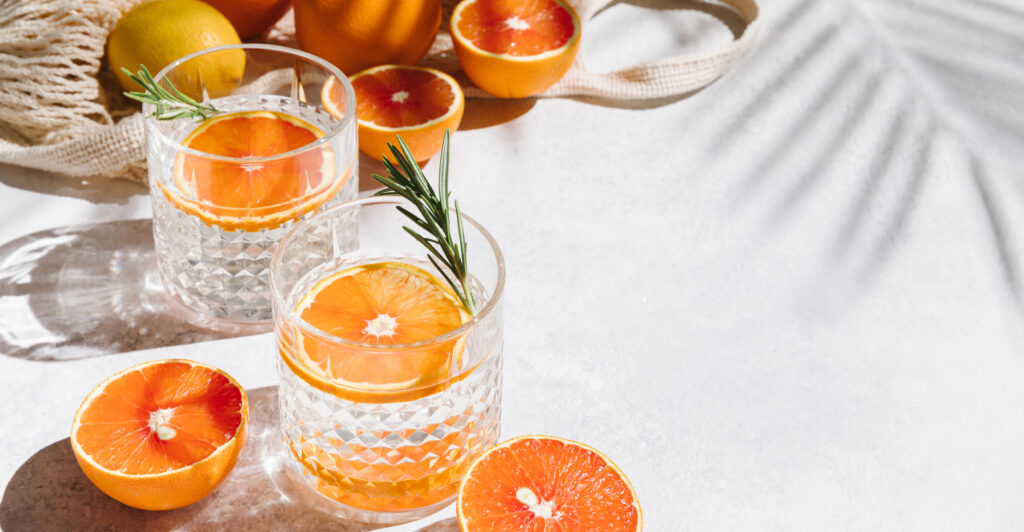A Toast to Health: Analyzing the Shift in the Low-and no-Alcohol Market
By Sydney Byrne (Riethman), Sensient Flavors & Extracts, Marketing Specialist
Insights by Adam Kitchen, Sensient Flavors & Extracts, Beverage Applications Technologist and Whitney Smart, Sensient Flavors & Extracts, Beverage Applications Manager
As published in the February 2022 issue of Perfumer & Flavorist
Experts Explore Consumer Interest and Manufacturing Challenges in this Evolving Market
Consumers are taking control of their health, and their beverage choices prove no exception as the RTD space is continually evolving.
From functional and beneficial to adventurous and exotic to low- and no-alcohol, significant shifts are occurring with health-conscious and functional ingredients continuing to trend.
Alcohol-Free Takes the Lead
With 17%a of adults in the United States looking to cut back on their alcohol intake, the low-to-no-alcohol innovation space is primed and ready for flavor concepts that will grab consumers’ attention. While there are multiple reasons why someone may choose not to partake in alcohol, consumers still want to indulge in a similarly crafted or artisanal mocktail rather than an iced tea or can of cola.
In an effort to appeal to the familiar, we are seeing the low- and no-alcohol category begin to merge and borrow flavor concepts from its counterparts. With more high, nuanced, and premium flavor profiles coming into the beverage industry as a whole, the low- and no-alcohol space is beginning to take hold of these to create exciting and fanciful flavor concepts that excite alcohol-free consumers.
Crafting for Balance
When crafting non-alcohol RTD beverage options, developers should focus on finding balance in the flavor profile between sweetness and acidity to create an easy-to-drink beverage that still holds a handcrafted cocktail’s premium and artisanal taste. By implementing exciting herbs, botanicals and floral notes such as sage, rosemary, basil, mint and thyme, beverage manufacturers can separate their products from the traditional soda or tea options.
Like non-alcoholic beer, various hop extracts and botanical notes can enhance hop flavor notes and the mouthfeel of beer without alcohol. By experimenting with various extracts and flavor notes in low- to no-alcohol RTD beverages, the gap that the lack of alcohol leaves behind gets filled with the excitement of new and surprising flavor concepts.
New Flavors Bubble Up Consumer Interest
The pandemic created the perfect setting for hard seltzers to amplify their messaging and better-for-you claims as one of their primary selling and differentiating points. As consumers continue to focus on their health and what they consume, some may choose to nix alcohol all together, while others may want to enjoy their spirits in a modified and functional way.
As this market continues to see unprecedented growth with new players emerging left and right, it is more crucial than ever to create flavors and concepts that will catch consumers’ eyes and palates.
The trend of reduced sugar, fewer calories, and fewer carbs has kept consumers excited and eager to try exotic and unfamiliar flavor concepts, with the most notable growth seen in the hard seltzer category. In fact, 31% of U.S. consumers aged 18 to 34 said they go out of their way to try new flavors, and 58% of U.S. adults say they like to try new flavors, demonstrating the need for creativity in this saturated market. Tropical flavors such as passion fruit, dragon fruit, pineapple, fruit punch, and unicorn are some examples of unique flavors that are beginning to pique consumers’ interest.
Overcoming Manufacturing Challenges
Attempting to change the taste and experience of a handcrafted cocktail can be difficult, one of those reasons being a significantly lower ABV. Most handcrafted cocktails are 12% to 20% ABV at a bar or restaurant, but due to tax concerns with alcohol, however, our consumers expect 5% to 9% alcohol. For RTD beverages outside of the alcohol space, a rise in functional claims can make it challenging to achieve the delicious taste that full-calorie, full-sugar beverages provide. By utilizing sweet modifiers and mouthfeel and texture enhancers, the beverage profile can be tweaked to something more palatable that will mask off notes of added functional ingredients like caffeine, protein, and nootropics.
A Flavorful Future
Health and wellness will continue to stay top of mind for consumers, primarily through the start of the new year. As more consumers look for functional ingredients, natural flavors and extracts will be a valuable tool for beverage manufacturers looking to meet clean-label standards, while appealing to adventurous palates.
Whether RTD beverages are full of spirits or low- or no-alcohol, beverage manufacturers must continue to support consumers’ desire to make responsible and healthy choices, even if they are indulging in alcohol. Since the “better for you” trend in food and beverages was established even before the pandemic, manufacturers and developers can expect to see this trend continue with strength moving into the future.
With more players than ever in the RTD beverage space, developers can continue to differentiate themselves by holding true to “better for you” claims, while also exploring and implementing adventurous flavor combinations, added functional benefits, and herbal and botanical extracts to enhance consumer perception and acceptance of this new wave of beverage innovation.
